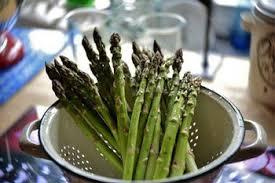Asparagus
-
Scientific NameAsparagus officinalis
-
General InformationPerennial vegetable with edible green stalks. Plants can live for 15+ years. Native to the coastal regions of Europe and Asia.
 Photo: UC Marin Master Gardeners
Photo: UC Marin Master Gardeners -
When to Plant
Transplant from one year-old crowns between January and March. For more effort, asparagus seeds may be pre-sprouted indoors in early spring and planted in a seed tray. Thin seedlings to three inches apart. Transplant seedlings in early fall in an amended bed.
-
Planting
Dig a trench area (depending on how much space you have) that allows each crown to be eight to 10 inches deep, 12 inches wide, and 12 to 18 inches apart. Place the crown on a mound at the bottom of the trench, fanning out the roots. Cover the crown with three to four inches of soil. As the shoots emerge, continue to fill the trench until it reaches ground level.
-
Soil Requirements
Loosen up the soil and remove weeds and old roots. Work plenty of compost and/or rotten manure into the top 12 inches of soil.
-
Water Requirements
Avoid wetting the foliage and spears with overhead watering. Water until the soil is wet several feet deep and allow it to drain. Unless your bed gets extremely dry, stop watering in September and October so that the plants will go dormant.
-
Fertilizing
When starting your asparagus bed, mix in generous amounts of compost and well-rotted manure. In subsequent years, in early spring, before the sprouts shoot up, add a high value nitrogen fertilizer such as hoof and horn meal, blood meal, or organic fertilizer blend made specifically for asparagus and available from your local nursery.
-
Pollination
The small, bell-shaped flowers are attractive to honey bees and other pollinators.
-
Harvesting
Patience! Do not harvest the first year if you started with one year-old crowns. The second year, harvest lightly for two weeks, then let additional spears develop into foliage. If you start with transplants or seed, do not harvest for two years. Then follow directions for one year-old crowns. Cut spears at soil level and avoid injuring the crowns. Years two to three you can harvest for eight weeks as spears emerge. Check your asparagus bed at least every other day to harvest the spears when the tips are tight and smooth. Once the tips separate the stalks will be less tender; this can happen quickly if the weather is warm. When new spears begin to thin to less that one-half inch in diameter, stop harvesting. Allow all future spears to develop into tall fern stalks that restore food to the roots.
-
Storage
Eat fresh or refrigerate spears for two to three days. Bundle the spears together, wrap a wet paper towel around the cut end, and place the bundle in a plastic bag.
-
Good Varieties for Marin
'UC 157' 'UC 72' 'Jersey' series, 'Mary Washington' 'Martha Washington'
-
Helpful Tips
When starting your asparagus bed, mix in generous amounts of compost and well-rotted manure. In subsequent years, in early spring, before the sprouts shoot up, add a high value nitrogen fertilizer such as hoof and horn meal, blood meal, or organic fertilizer blend made specifically for asparagus and available from your local nursery.
-
Common Problems
Minimal harvest: Don’t over harvest your bed initially. A well-established bed will produce better in the long-term. Consider beginning to harvest in year three. Keep the area free of weeds to minimize competition.
-
Pests- Diseases & More
Rust, aphids, snails, slugs, or beetles can bother asparagus. Plant rust resistant varieties, and check plants often for pest damage.
For more information and solutions: http://ipm.ucanr.edu/home-and-landscape/asparagus/

